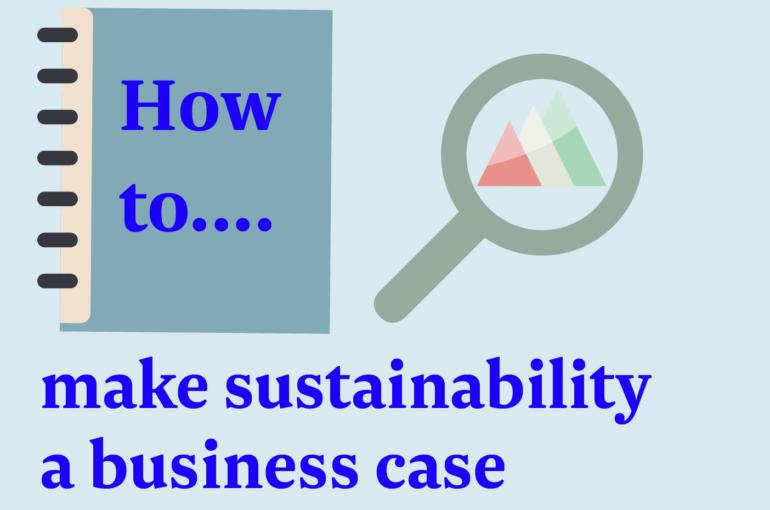How to… make sustainability a business case

Our goal is to make impact fun and accessible for every company. In our “How to…” blogs you find practical tips, steps and insights every other week. This way all brands can take sustainability to the next level! This week’s blog is about the business case of sustainability.
Sustainability is not expensive: 5x sustainability as business case
Making sustainability integral part of your business takes time. It requires a certain effort, a degree to which you rethink the way you designed your business and operations. It may require a certain investment: in time as well as energy and money. But: contrary to what you might think, sustainability is not expensive. It offers financial perspectives in multiple ways, but this requires a long term vision, and short term economic gains can divert your attention from it. How do you make sustainability a business case?
1. Create savings
No matter the industry, it makes sense that if you save resources, you save money. At your headquarters, warehouses, shops or even service centers: you can bring down business costs significantly, while building a more sustainable business. Focus on energy-efficiency, deploy water saving measures, convert residual heat, use eco-efficient installations, isolate buildings, challenge your team to travel less, reduce the amount of samples or strip your packaging. The examples are endless, but we conclude: energy and resource-efficiency is the way to start with sustainability and saving money. A second step can be: investing in renewable energy. We all understand that solar panels on your rooftop result in lower energy bills and “free energy” in the long run. When you invest in a smart way, you can minimize the payback time too.
2. Get more out of your resources
The awareness that we have a finite number of resources to our disposal is growing. It’s a big risk to be dependent of resources that are scarce or (will be) depleted, both for companies as investors. A risk for your business model and production continuity, but also for your brand reputation or competitive position. Besides, we didn’t care much about the waste streams that were generated along the production process for a long time. Which results in a spill of resources, time and money. While you could reuse residual materials in your production (to create different or lower-segment products); use recycled fibers in the first place; or offer your product as a service, so you remain responsible for your product and treat waste streams differently.
See how RotterZwam grows mushrooms on used coffee grounds for example, or how DutchSpirit set-up a lease concept for tailored suits.
3. Cut out the middleman
Many companies depend on international supply chains that are low-cost and often complex. International sourcing results in multi-tiered supply chains that often involve many actors. Labour costs are only 20% of the price. Traders, agents, exporters are the ones that all add their own mark-up, while blurring your supply chain. While transparency should ensure you that suppliers are operating in line with how you want to do business. Cutting these middle-men out could not only help you build more transparency; it also lowers cost by preventing margin add-ups. AND: it enables you to offer a fresher product, when it comes to fast-moving consumer goods, cosmetics or flowers, because a shorter chain means you can provide your consumer faster.
Bloomon offers its consumers more value for money with an increased lifetime of their flowers, while lowering their own costs.
4. Paying a true price
Business as usual appears to be cheaper, but aren’t we paying for the “hidden” social and environmental costs? Yes we are. Via taxes, cleaning costs, institutional fees and other costs to patch-up our earth. All these indirect costs make our products very expensive, and we are hardly aware of it. The pressure for efficiency forced companies to cut back on anything that didn’t have a clear price. As a result, companies do not see these “hidden” costs: from human rights to environmental pollution. We should integrate all external costs into the “true price” of the product. Then, we come to realize that fair, cleaner and more sustainable production is actually cheapest in the long run. It’s proven that paying a true price, in the end, is more affordable.
Read more about Eosta’s approach to True Price, or check this video by ABN Amro’s research.
5. Put your money where risks are low
Investors go green. Even the world’s largest investors and asset management companies, like Blackrock, have signaled to turn down companies on sustainability measures. There’s a risk to invest in old industries and business as usual, and this trend translates to finance flows. This creates a possibility to boost your business by finding investors that support your sustainable, responsible or circular business idea. It’s your opportunity for growth. Even the biggest investors are specifically looking for investments with no (or low) climate risks and seriously take social and environmental costs into account. It’s not only about “going all-in on sustainability”: companies like Blackrock are willing to support companies that make their current portfolio more sustainable.
Read more on Blackrock’s approach or how PYMWYMIC promotes the direct link between social and environmental returns and financial returns.
Sustainability is not expensive, it only requires a long term vision and sometimes a little courage. In the end, your brand will suffer more damage from shameful practices, than the cost to get your house in order. Think of Albert Heijn, being confronted by Wakker Dier with their “plofkip” production. Or Facebook being boycotted by advertisers “until stricter policies are put in place to stop racist content.” Also, when you identify the measures most relevant to your business and integrate them in the right way, it will in fact give you a competitive advantage. And, it enables you to attract (and retain) new potential business customers, consumers (and even investors).
We’re happy to think along and help you identify what business opportunity is awaiting for your company.